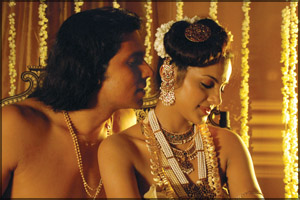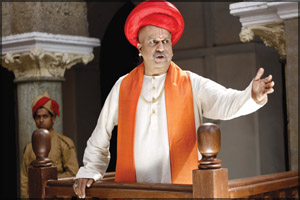arts
Colourful passage of discovery; pictorial excellence
Artist's perpetual quest for creative freedom:
Film Review
by Indeewara THILAKARATHNE and Ranga CHANDRARATHNE
[email protected]
The Asian premiere of Ketan Mehta's latest film Rag Rasiya (Colours
of Passion) was held in the enchanting port city of Galle as part of the
fundraiser events leading to the Galle Film Festival of 2009 (GFF).
|
The Chairman of
the National Film Corporation Jayantha Dharmadasa and the staff,
the Chairman of the Public Performances Board Asoka Serasinghe
and the staff, the Chairman of the Tourist Board Renton de Alwis
and the staff, the founders of the GFF Geofferey Dobbs and
Damita Nikapota, the festival director Boodee Keerthisena should
be commended for the joint effort in creating a platform for
screening internationally acclaimed films aimed at creating a
vibrant film culture in Sri Lanka in general and making Galle a
festival city. Associated Newspapers Ceylon Limited is the media
sponsor for the event. |
|

It is at the hand of the artist that an ordinary woman become a
Goddess but bogus cultural puritas may make her a whore |
The film is based on a biography of 19th century legendary Indian
painter Raja Ravi Varma by Marathi novelist Ranjith Desai. Apart from
the poignant love story between Raja Ravi Varma (Randeep Hooda) and his
muse Sugandha (Nandana Sen), the film brings up issues of creative
freedom, notion of morality and above all the artist's perpetual
struggle for creative freedom especially against the backdrop of rising
extremism which poses a serious threat to artistic freedom and freedom
of expression.
The story unfolds in a court room where the celebrated painter Raja
Ravi Varma is charged with obscenity, immorality and offending religious
sentiments by painting Indian mythological characters in nude. Ketan
Mehta skillfully intermingles contemporary reality with the past as the
film drifts from past to the present. Visually outstanding and
professionally perfect Rang Rasiya is perhaps, one of the best films to
emerge from India.
Though the film is primarily set in 19th century India, issues of
creative freedom which Ketan Mehta convincingly brings up in the form of
a lengthy trial, which reminded us of the famous trial heard against D.H
Lawrence's "Lady Chatterley's Lover "on the same charges of immorality
and obscenity verses artistic and creative freedom, are of universal
relevance at all times. During the course of the trial, Raja Ravi Varma
(brilliantly portrayed by Randeep Hooda) points out that nudity has been
extensively used in Indian classical art, paintings and in mythology as
a mode of expression and is part and parcel of great Indian artistic
legacy. And he had not offended religious sentiments by rendering his
muse's face (Sugandha's face) to classical paintings and commercially
printing them en mass that take Varma's arts to every nook and corner of
India. Having heard the eloquent testimony made by Varma, Court 'honourably
acquitted 'him of all charges framed against him. Though Varma is
acquitted, his muse Sugandha committed suicide after her testimony
before the court.
Bold attempt
Ketan Mehta should be commended for bringing out issues relevant to
the modern era at a time a wave of racial, religious and cultural
intolerance is sweeping across the continent. Rise of extremism and
fundamentalism has been observed in many lands including in India at the
expense of creative freedom and freedom of expression. Rang Rasiya is a
film where contemporary reality is in the garb of history. It is no
secret that issues faced by Raja Ravi Varma hundred years ago, are still
and would face by artists irrespective of culture, nationality or the
country and time they live in. Therefore, the central theme of the film
is universally applicable. The last scene the climax of the film where
extremist stormed into the auction hall where Raja Ravi Varma's
priceless painting is going under the hammer, among other things,
suggests that artist's quest for creative freedom is a life long
struggle.
On the other hand, auction also a symbol of commercialism which has
become an inescapable reality. Since transformation of society from
feudalism to capitalism, Artists lost traditional patronage and instead
they have to rely on the market. Ravi Varma arrives in the city of
Bombay following his patron's demise and started a printing press with
Fritz Schleicher, a German master printer. The mass production of his
paintings not only makes them popular but also brings much -needed
capital to Varma who by now becomes a wealthy much sort after artist. It
is also Varma who holds, perhaps, India's first exhibition of paintings
for the public. Ketan also indirectly suggests that with
commercialisation of art, the doors have been opened for the public to
enjoy it until then art, especially classical art had been a prerogative
of the elite.
|

Artistís creative freedom won over extremism |
Following the suicide of his muse Sugandha, Raja Ravi Varma continues
with his work unabated by the tragedy that befell on him. However, since
India culture believe in reincarnation or life after death, Sugandha's
death marks her departure from the world and perhaps, union with Gods
like the Uruvashi's story where the goddess will have to go back to
heaven if her true self (naked body) is revealed. Suicide is as if she
has released herself from worldly burden and unites with the gods.
Excellent cinematography
Rang Rasiya is exceptional on many counts including its excellent
photography, insightful script which has embedded many issues in it and
outstanding casting. For instance, well-researched script detailed out
the historical figure Raja Ravi Varma and his work.The depicting of 19th
century India, socio-cultural background of the time including attire
make the film a fascinating journey into history of India dominated by
Maharajas and also re-visiting colonial India under the British rule. It
is obvious from the very footages of 19th century court room that
research has been a dynamic component of the script. Ketan Mehta is also
excelled in amalgamating the central theme of the film creative freedom
verses fundamentalism into the script.
Some of the dialogues are both insightful and evocative. For
instance, in Sugandha's testimony the entire attitude towards women from
different perspectives is eptomised in lines "This man turned a woman
like me into a goddess and you turned me into a whore". Another instance
where dialogues excelled is when Raja Ravi Varma gradually proved
charges of obscenity, immorality and offending the religious sentiments
bogus to the acclaim of the judges. The last scene of the film sums up
the central theme that the quest for artistic freedom should be
constantly fought against the rise of demagogues and their rubble
rousing cry of fundamentalism and religious fanaticism.
Exceptional casting
Casting plays a vital role in a film as actors and actresses become
vehicles of emotions. It is no wonder that real life characters on the
silver screen contribute to the re-creation of authentic characters that
would etch in the minds of the audience. From the very first frame,
casting in the film Rag Rasiya seems to be exceptional. Especially the
characters of Raja Ravi Varma (Randeep Hooda) and his muse Sugandha (Nandana
Sen) are played with capturing subtle nuances which represents not only
socio-economic background of them but also an entire milieu. Director
Ketan Mehta as well as Randeep Hooda and Nandana Sen should be commended
for bringing to life historical figures and a fascinating era in
pre-colonial India.Character of Raja Ravi Varma is the main lead role in
the film.
Since it demands extreme patience and a load of research into the
milieu in which the historical figure lived, it would have been a
daunting task for Randeep Hooda to portray Ravi Varma. However, he has
portrayed it brilliantly overcoming many hurdles, offering the audience
a glimpse into the physical and psychological traits of the historical
figure.
Sugandha's character which is brilliantly portrayed by Nandana Sen
has been a well-developed character, once again, encapsulating subtle
nuances of the character, representing socio-economic background and
that milieu the story is set against. Particularly Nandana Sen has
portrayed the intimate scene with colours of passion all over their
bodies. It is one of the best scenes in the film.
As a director Ketan Mehta makes an important milestone with Rang
Rasiya (Colours of Passion). More than anything else, Ketan Mehta is
marked for his highly evolved cinematography and complex diction which
has excellently translated history into convincingly and aesthetically
satisfying visuals.
Since the story is of a celebrated painter, special attention has
been paid on the use of colours. Rang Rasiya (Colours of Passion) will
remain as a film where history is skillfully intermingled with
contemporary reality.
Painting exhibition
By Sandasen MARASINGHE
"Reflective Landmarks", Sanjeewee Seneviratne's fourth solo water -
colour painting exhibition will be held at the Lionel Wendt Art Gallery
from November 15 to November 17.
The massive buildings as the National Museum, the Galle Face Hotel,
the Old Parliament Building, the Town Hall Building near which I felt I
was dwarf created some kind of curiosity and interest in me. These
buildings can be viewed from different angles like political, social,
cultural etc. but they are the ones that have witnessed all the changes
of a transition period before and after freedom was achieved" Sanjeewee
was explaining the subject of his painting exhibition. "As well as all
these buildings that remind us of the period before the freedom there
are characters like the mobile tea markers, bullock carts, basket
carriers and men at the hand carts unchanged reminding us of the period
before the independence achieved.
These Landmarks and characters, as I see, are the reflections of that
transition. This is exactly what I mean by 'Reflective Landmarks'.
Sanjeewee Seneviratne who passed out from the Fine Arts Department of
the Kelaniya University with a Bachelor of Arts Honours degree brings
Gangarama Siemamalakaya, the Dutch Reformed Church, the Clock Tower,
Pettah, the Oratary St. Paul's, Pettah, the Galle Face Green on the
water - colour paper. He also brings the unchanged Porters in the
evening. Tamil ladies, the Mobile Tea Maker, A Shelter Over the Figures
and many others before your eyes on average 25 cm by 35 cm watercolour
papers among his 35 watercolour paintings at the exhibition.
The exhibition will declare open by Professor Nimal de Silva of the
Faculty of Architecture, University of Moratuwa. |

